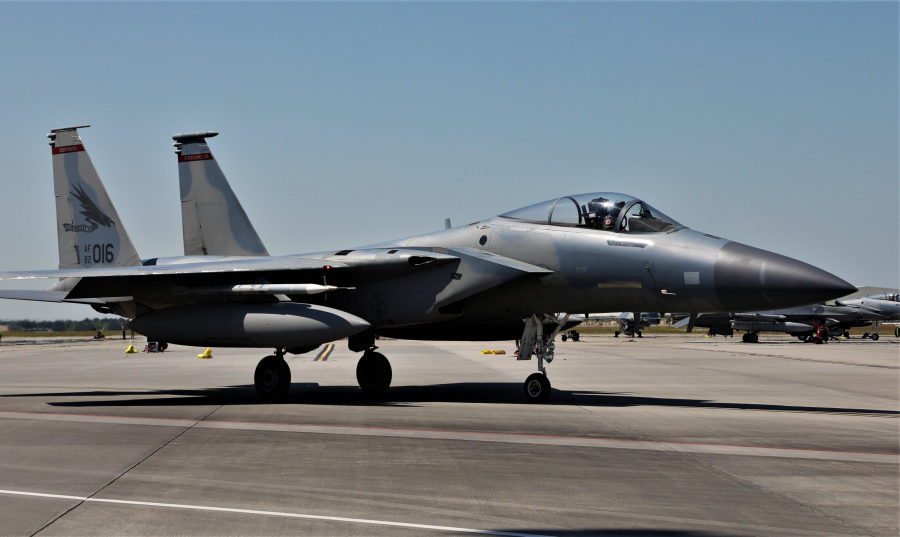The Air Force and Navy are both seeing a long-term, downward trend in aircraft availability and flying hours per aircraft, which is actually worse than the Pentagon reports because of the way the Defense Department counts aircraft as ready for duty, according to a new report from the Congressional Budget Office. While USAF availability recovered a little during the COVID-19 pandemic, flying hours continued to fall, the CBO said.
The Pentagon’s stated aircraft availability is higher than the CBO’s because the Defense Department counts some aircraft as ready for action even if they are torn down for maintenance at their owning unit—not in depot—or are in storage, the audit agency said. The Air Force measures “availability” as “mission capable” rates, and these metrics have changed over the last couple of years.
While the CBO provided only broad graphs and not specific numbers, it showed USAF’s availability for all aircraft as declining from about 60 percent in 2000 to less than 45 percent in 2020, with a similar performance in fighter/attack aircraft (though the F-35 reports differently and was not reflected in the CBO’s charts).
Over the same period, flying hours for all USAF aircraft declined from an average of about 300 per year to about 230. Air Force fighter/attack aircraft flew an average of about 200 hours per year in 2000, gradually declining to about 125 hours per year on average. The peak of both availability and use was in 2008.
For a more granular look, the CBO examined the F-15C/D and F-16C/D and found that their availability declined from just under 70 percent for both aircraft in 2000 to about 55 percent for the F-16 in 2020, while the F-15 came in about 45 percent. In flying hours per year over the same period, both were running about 260 in 2000 but had fallen to about 150 for the F-16 and 110 for the F-15 by 2020. Peak availability for the F-15 and F-16 was in 2008.
For rotary and tiltrotor aircraft, USAF saw availability rates at around 60 percent through 2012; followed by a decline to about 55 percent through 2016; and a subsequent recovery to about 58 percent. Flying hours per aircraft per year were at 275 in 2000, and after ticking up to 300 by 2010, have declined to about 240 hours per year.
With ups and down of as much as 10 percent over the past 20 years, Air Force trainers are where they were in 2000, at an availability of just over 60 percent. From just under 300 a year in 2000, trainer flying hours per aircraft got up to about 320 per year by about 2006 and have since declined to about 270.

The Air Force saw a bump in availability of all aircraft due to the COVID-19 pandemic.
The availability rate “rose from 49 percent in February 2020 to a peak of 54 percent in April 2020, falling to 49 percent in September 2020 and March 2021,” the CBO reported. However, USAF saw a precipitous drop in annual flying hours per aircraft.
“In April, 2020, the Air Force flew 69 percent as many hours as it typically did before the pandemic” and was still at only about 82 percent of its pre-pandemic high water mark by February 2021, according to the report. “By March 2021, it had recovered to pre-pandemic levels of flying hours.” The CBO speculated that flying less led to a greater availability of spare parts, thus improving the aircraft availability numbers.

To illustrate the disparity between how the CBO calculates availability versus the Air Force, it used the Pentagon’s numbers for the F-15C in 2019. In that year, “the Air Force had 304 F-15Cs,” declaring an average of 121 to be mission capable “and possessed by operators,” the CBO said. However, 110 airplanes were “coded as mission capable but could not be flown on combat or training missions, because 17 were undergoing depot-level maintenance and 93 were in storage.”
By the DOD’s counting, in 2019, “67 percent of F-15Cs were available … [121 out of 180].” The CBO, however, counted “all aircraft, including those in storage or … depot … as part of the fleet. By CBO’s measure, 40 percent of F-15Cs were available [121 out of 304].”
The audit agency suggested that its method is a more realistic way to assess the true availability of aircraft for training or combat, since it is unrealistic to assume that aircraft in storage or heavy depot could be rapidly made ready for action.
The Navy’s decline in availability of the 2000-2020 period was more pronounced than the Air Force, but the Navy flew its aircraft more per tail than USAF did over the same period. The availability of the F/A-18C/D has fallen more than any other fighter that CBO looked at.

